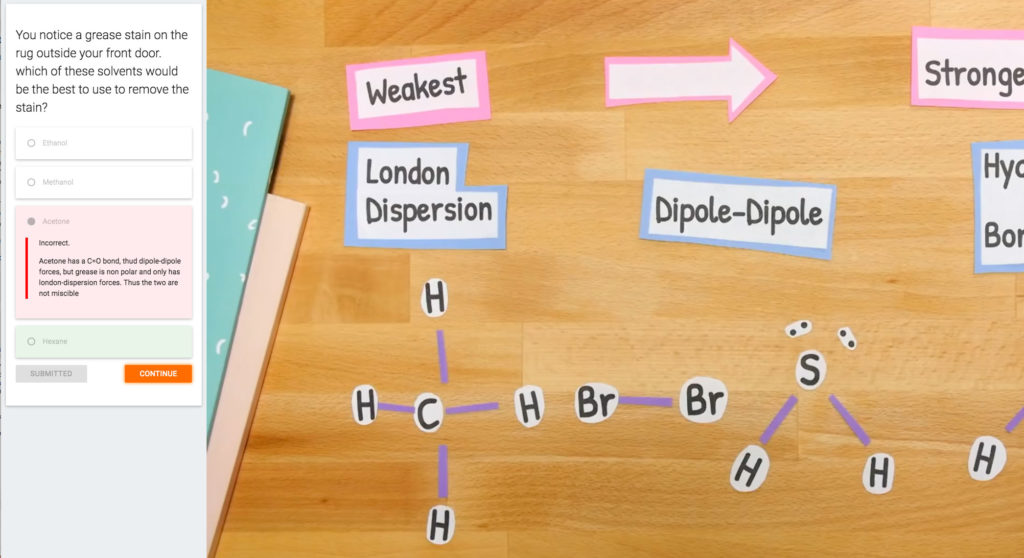Integrate interactive video in STEM courses
Reading long text is monotonous, particularly in science-based courses that tend to have iterative applications and references to previously learned concepts. An interactive video is a unique tool that makes use of visual and auditory elements to enhance learning.
Introductory science classes, such as general chemistry courses, are usually large and have students with vastly differing proficiencies and interests in the subject matter. While the goal may be to impart the student with specific knowledge/skills, it is not always possible to bridge these knowledge gaps beyond the classroom’s given time/logistical constraints. As such, students may feel constrained by the subject matter and not fully grasp the scope of application of certain concepts. For example, while chemical equilibria may be an abstract concept when introduced theoretically, a biologist would be interested in how those principles apply to maintaining blood oxygen concentration. A geologist would be intrigued by application of the same concepts to weathering of limestone. A chemical oceanographer might be intrigued in using the knowledge to better understand ocean acidification. Interactive video allows for creation of highly engaging material that can be used to generate interest and give students more tangible access to coursework material.
A few quick ideas that would help you get the most of interactive video as a pedagogical tool are highlighted below.
- Know the lay of the land. Before developing new interactive video, set your learning objectives. Interactive video tools such as PlayPosit have inherent value by inserting quiz and discussion elements in pre-existing or newly recorded videos. It is prudent to review existing learning material for content and presentation formats.
- Focus area should promote further inquiry. The choice of subject matter for videos should always be intriguing and provoke further ideas for inquiry and discussion. The interactive video provides an opportunity to merge both instructional and exploratory elements of the course. Current issues in science or in news headlines may promote student engagement with interactive videos while helping reinforce and apply elements encountered within the class/lab setup. Interactive videos can be used to guide student-led inquiry projects, labs, and papers to ensure the required breadth and depth are attained.
- Provide opportunities for student remediation, review, and reinforcement. Interactive video allows for the ability to add different types of questions or reflective pauses to enhance student engagement. Autograded question types are helpful as all grading is asynchronous, and students can have multiple attempts at the questions presented. For the auto-graded questions (fill in the blank/multiple-choice/check all), feedback elements can be given to the student depending on the answers given/chosen. When adding quiz elements to an instructional video, use notes within responses to highlight key areas, provide queries for further inquiry, and direct students to resources if in need of further explanation. It can also be used to point out common misconceptions, break down complex concepts or help distinguish between confusingly similar items.
- Make, Review, Edit. It is important to have a good grasp of how much content can seamlessly and effectively be contained in one video. Videos longer than 10 minutes tend to have less student engagement. This may require a few iterations to reach a level where you are comfortable with the format, content, and delivery of your video. In a similar vein, once metrics and student response is obtained, certain elements can be fine-tuned to enhance presentation and effectiveness.

UAF CTL provides PlayPosit to all UAF instructors. For more information, read this teaching tip.
Resources:
Shahrokni, Seyed Abdollah. (2018). Playposit: Using interactive videos in language education. Teaching English with Technology. 18. 105-115.
Lawrence Itela
Lawrence Itela, MS, is a doctoral student in the UAF Department of Chemistry & Biochemistry and was a Summer 2018 Graduate Fellow at UAF CTL. He holds more than five years of experience teaching undergraduate courses in General and Physical Chemistry with research interests in environmental chemistry and chemical education and learning.



Interactive video lessons are much harder to create as there is a lot of planning involved just to get a 10 minute video done. Thank you for sharing these tips. They’ll definitely help me with my future video lessons that I’ve been creating on my website.